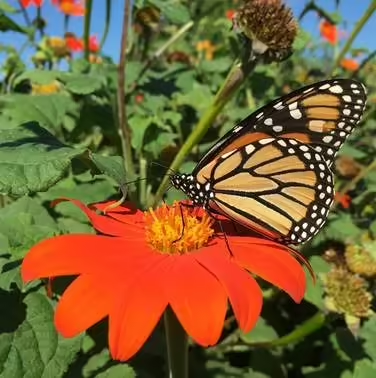An Oregon State University research study featured in Science Daily tracked butterfly abundance in Ohio over the last 20 years has discovered a 33% decline. We can only assume that in Illinois we have similar patterns in the decline in our butterfly populations. Scientists believe the decline may be attributed to climate change, habitat degradation, and agricultural practices.
“The yearly count of monarchs decreased by 53% in 2020 from the following year,” says University of Illinois Horticulture Educator Kelly Allsup. "This most recent drop may not be directly correlated to our reduced milkweed numbers; drought and other environmental factors are also contributing to the problem; however, the decrease in the monarch population over time can be attributed specifically to a lack of milkweed for larvae," says Allsup.
Milkweed is the only plant that monarchs will lay eggs on, and it is the sole food source for monarch larvae when eggs hatch.
With decreasing numbers in the pollinator populations, Livingston Master Gardeners like Cathy Montgomery are ready to help gardeners increase habitat for these insect visitors. Join Cathy and other Master Gardeners at the Catherine V. Yost House Museum for a program on gardening for pollinators. Master Gardeners will highlight the early bloomers of spring and the late bloomers of fall to contribute to pollinator health at times when resources are limited. Gardeners will show how a historic garden flowers like zinnias, coneflowers and herbs can also contribute to the bees and the butterflies.
Master Gardeners will host a booth from 1 to 3 p.m. outside the Yost House located at 298 W. Water Street, Pontiac on Saturday, August 21. Visitors will receive pollinator handouts highlighting the best plants in the garden and strategies to conserve pollinators. Participants will also get to take home a posy of pollinator blooms from the garden by highlighting them in Tussie Mussies.
Originating in the Victorian era, Tussie Mussies are small, round bouquets made up of herbs and flowers that each hold symbolic meaning. Cathy and the Master Gardeners intend to highlight flowers and plants that help attract pollinators to the garden in the posy of blooms.
There is no cost or registration to attend. For questions or if you will need an accommodation in order to participate, please contact us at the Livingston County Extension Office at 815-842-1776. Early requests are strongly encouraged to allow sufficient time to meet your access needs. For more information about Extension, Master Gardeners, and upcoming programming, visit us at go.illinois.edu/LMW.
Photo Caption: With decreasing numbers in the pollinator populations, Livingston Master Gardeners are ready to help gardeners increase habitat for these insect visitors. Find out how you can help by stopping by Yost House on August 21. (University of Illinois Extension)
SOURCE/WRITER: Kelly Allsup, Extension Horticulture Educator, Livingston, McLean & Woodford Counties
ABOUT EXTENSION: Illinois Extension leads public outreach for University of Illinois by translating research into action plans that allow Illinois families, businesses, and community leaders to solve problems, make informed decisions, and adapt to changes and opportunities.
